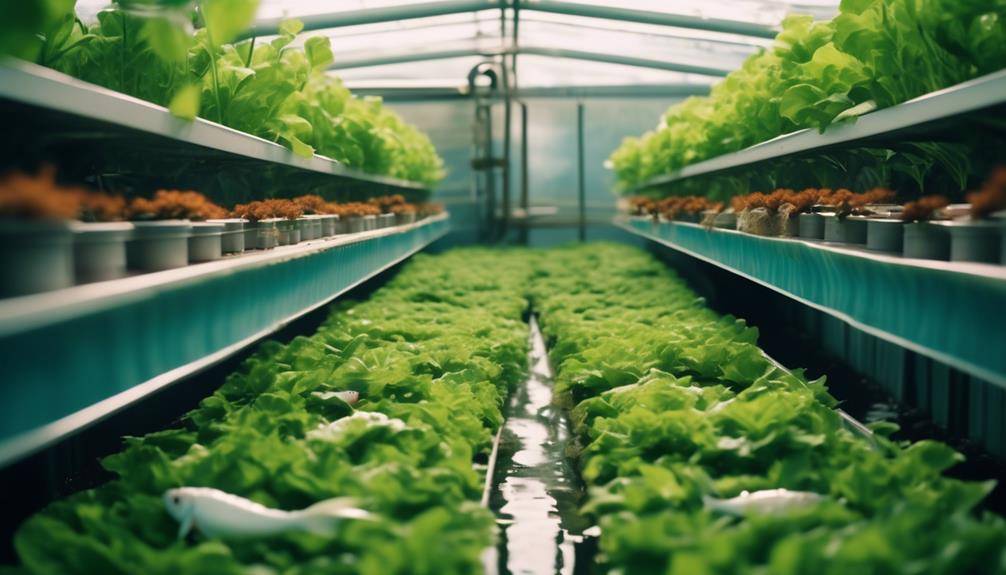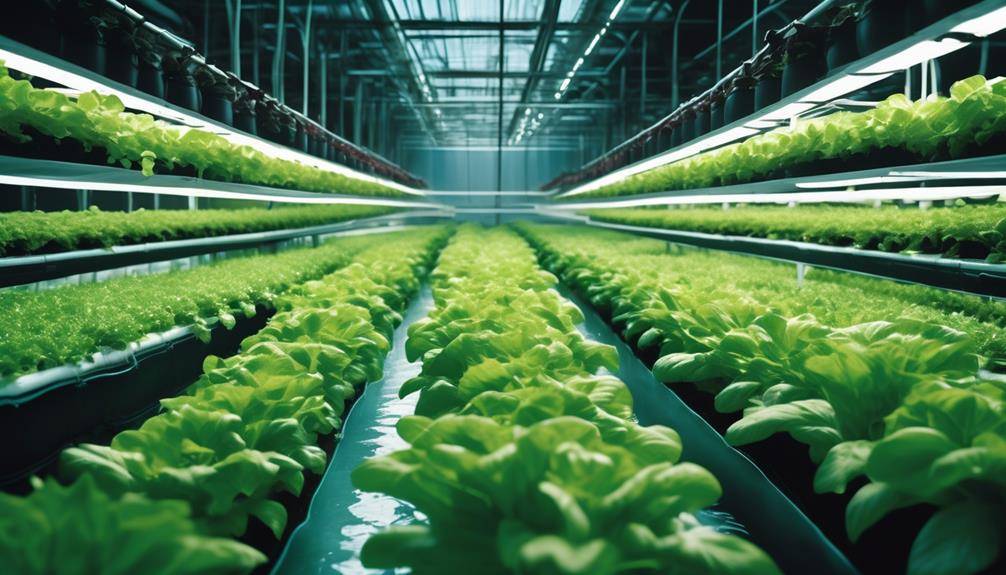Explore The Best Aquaponics In Farming Pros And Cons

Aquaponics In Farming Pros And Cons; Have you ever wondered if there is a more sustainable and efficient way to farm? Well, coincidentally, aquaponics might just be the answer you’re looking for. With its innovative approach combining aquaculture and hydroponics, aquaponics has garnered attention as a promising farming method. But before you dive into the world of aquaponics, it’s important to weigh the pros and cons. In this discussion, we will explore the benefits of aquaponics, such as efficient resource utilization and reduced use of chemical fertilizers, as well as the challenges and limitations it presents. So, let’s take a closer look at the fascinating world of aquaponics and what it means for the future of farming.
Efficient Resource Utilization
Efficient resource utilization is a crucial aspect of aquaponics farming, as it maximizes the use of inputs such as water, nutrients, and energy to sustain both the fish and plant components of the system. Aquaponics is a sustainable farming method that combines aquaculture (fish farming) with hydroponics (growing plants in water) in a symbiotic relationship. One of the key advantages of aquaponics is its efficient water usage.
In traditional agriculture, water is often wasted due to evaporation, runoff, and inefficient irrigation systems. However, in aquaponics, water is continuously recycled within the system. The fish waste, rich in nutrients, is converted into a form that can be absorbed by the plants. As the plants take up these nutrients, they purify the water, which is then returned to the fish tanks. This closed-loop system significantly reduces water consumption compared to conventional farming methods.
Furthermore, aquaponics uses sustainable farming methods to optimize resource utilization. By integrating fish and plant production, it eliminates the need for synthetic fertilizers and pesticides. The fish waste provides a natural source of nutrients for the plants, eliminating the need for chemical additives. This not only reduces the environmental impact but also ensures that the produce is free from harmful residues.
Additionally, aquaponics reduces the energy requirements for farming. Conventional agriculture often relies on heavy machinery, irrigation systems, and transportation for inputs and outputs. In contrast, aquaponics operates on a smaller scale, utilizing natural processes and minimizing the need for external energy sources. This makes it a more energy-efficient farming method, contributing to overall sustainability.
Minimal Water Consumption
Aquaponics offers significant water efficiency benefits, making it a sustainable farming practice. By integrating fish and plant cultivation, water is continuously recycled, minimizing consumption. This closed-loop system reduces the need for large quantities of water, making aquaponics an environmentally friendly choice. Additionally, the efficient use of water in aquaponics allows for increased crop yields, as plants receive a steady supply of nutrients from the fish waste, resulting in healthier and more productive plants.
Water Efficiency Benefits
With its minimal water consumption, aquaponics offers significant water efficiency benefits in farming. Aquaponics is a sustainable farming method that combines aquaculture and hydroponics, allowing farmers to grow fish and plants in a symbiotic environment. This system recirculates water, reducing the amount needed for irrigation by up to 90% compared to traditional farming methods. The water used in aquaponics is continuously filtered and reused, minimizing wastage and conserving this valuable resource.
This not only benefits the environment by reducing water usage, but also provides cost savings for farmers. A cost effectiveness analysis has shown that aquaponics can significantly reduce water bills, making it an attractive option for farmers looking to improve their water efficiency and reduce operating costs. By embracing aquaponics, farmers can contribute to sustainable agriculture and ensure the responsible use of water resources.
Environmental Sustainability
The minimal water consumption of aquaponics makes it an environmentally sustainable farming method. Aquaponics systems use up to 90% less water compared to traditional soil-based farming methods. This water efficiency benefit has a positive environmental impact by reducing water usage and conserving this precious resource. Additionally, aquaponics eliminates the need for synthetic fertilizers, which can lead to water pollution and harm ecosystems. The system relies on the natural symbiotic relationship between fish and plants, creating a closed-loop system that minimizes waste and maximizes resource utilization.
This not only reduces the environmental impact but also enhances the economic viability of aquaponics farming. By minimizing water consumption and eliminating the need for chemical inputs, aquaponics offers a sustainable and economically viable solution for agriculture.
Increased Crop Yields
This water efficiency benefit not only contributes to environmental sustainability but also plays a crucial role in increasing crop yields through minimal water consumption. Aquaponics systems utilize the water from fish tanks, which is rich in nutrients, to nourish plants. As a result, the plants receive increased nutrient levels, promoting healthy growth and higher yields. The combination of water and nutrient circulation in aquaponics eliminates the need for synthetic fertilizers, reducing the use of pesticides. This is beneficial as it minimizes the exposure of crops to harmful chemicals, resulting in reduced pesticide use.
Additionally, the closed-loop system of aquaponics prevents water wastage through evaporation or runoff, further enhancing its water efficiency. By maximizing the utilization of water and nutrients, aquaponics offers a sustainable solution for increasing crop yields while reducing environmental impact.
Year-Round Crop Production
Year-round crop production is a key advantage of implementing aquaponics in farming systems. With traditional farming methods, crop production is often limited to specific seasons due to factors such as weather conditions and availability of natural resources. However, aquaponics allows farmers to bypass these limitations and cultivate crops throughout the year. This can lead to increased profitability and more consistent food supply.
Here are a few reasons why aquaponics enables year-round crop production:
- Controlled Environment: Aquaponic systems can be set up indoors or in greenhouses, providing a controlled environment for crop growth. This allows farmers to manipulate factors such as temperature, humidity, and light intensity to create optimal growing conditions regardless of the external climate. By eliminating the dependence on natural seasons, farmers can grow crops continuously and maximize their potential profitability.
- Efficient Resource Utilization: In aquaponics, fish waste provides nutrients for plants, while the plants filter and clean the water for the fish. This closed-loop system ensures that resources, such as water and nutrients, are efficiently utilized. As a result, crops can grow faster and produce higher yields compared to traditional farming methods. By maximizing resource efficiency, farmers can achieve a higher crop turnover rate and maintain year-round production.
Reduced Use of Chemical Fertilizers
To further enhance the sustainability of aquaponics in farming systems, another notable benefit is the reduced use of chemical fertilizers. Aquaponics is a sustainable farming method that combines aquaculture and hydroponics. In this system, fish waste provides nutrients for plant growth, eliminating the need for synthetic fertilizers.
Chemical fertilizers have long been used in conventional farming to promote plant growth and increase yields. However, their use can have negative environmental impacts, such as water pollution and soil degradation. Aquaponics offers a solution to these problems by minimizing the reliance on chemical fertilizers.
In aquaponics, fish waste provides organic nutrients that are broken down by beneficial bacteria into forms that plants can absorb. This natural process, known as mineralization, releases essential elements like nitrogen, phosphorus, and potassium into the water. These nutrients are then taken up by the plants, promoting healthy growth.
By using aquaponics, farmers can significantly reduce their reliance on chemical fertilizers, thereby reducing the environmental impact of their operations. This reduction in chemical inputs helps to safeguard water quality and preserve soil health. It also eliminates the risk of over-fertilization, which can lead to nutrient runoff and eutrophication in nearby water bodies.
Furthermore, the reduced use of chemical fertilizers in aquaponics aligns with the principles of sustainable farming methods. These methods aim to minimize the use of synthetic inputs and promote natural processes. By harnessing the symbiotic relationship between fish and plants, aquaponics offers a more environmentally friendly and sustainable approach to food production.
Natural Pest Control
When it comes to natural pest control in aquaponics farming, there are two main approaches: pest-repelling plant choices and the use of beneficial insects for control. By carefully selecting plants with natural pest-repelling properties, such as marigolds or basil, you can help deter pests from infesting your crops. Additionally, introducing beneficial insects like ladybugs or lacewings can provide a natural defense against common pests, as they prey on harmful insects. These methods offer a sustainable and chemical-free solution to pest control in aquaponics farming.
Pest-Repelling Plant Choices
One effective method for natural pest control in aquaponics farming is selecting pest-repelling plant choices. By strategically choosing certain plants, you can create a natural barrier against pests, reducing the need for chemical pesticides and promoting a healthier, more sustainable farming system. When deciding on pest-repelling plant choices, it is important to consider the specific pests you are dealing with and the conditions of your aquaponics system. Here are two sub-lists that can help guide your selection:
- Plants that repel insects:
- Marigolds
- Basil
- Nasturtiums
- Plants that attract beneficial insects:
- Dill
- Sunflowers
- Yarrow
These plants not only deter pests but also attract beneficial insects that prey on pests, creating a natural balance in your aquaponics system. Incorporating pest-repelling plant choices into your organic pest control methods can help maintain a healthy and thriving ecosystem.
Beneficial Insects for Control
Beneficial insects play a crucial role in natural pest control within aquaponics farming systems. These insects are an effective and sustainable method for managing pests without the need for harmful chemical pesticides. By introducing beneficial insects into the aquaponics system, farmers can rely on these natural predators to control and reduce pest populations. Ladybugs, lacewings, and predatory mites are commonly used beneficial insects in aquaponics. Ladybugs, for example, feed on aphids, mites, and other small insects, while lacewings prey on aphids, whiteflies, and mealybugs.
Predatory mites, on the other hand, target harmful pests like spider mites. These beneficial insects are strategically released into the system, where they establish a population and contribute to pest control, ultimately safeguarding the health and productivity of the aquaponics farm.
Sustainable and Environmentally Friendly
Aquaponics, a sustainable and environmentally friendly farming method, utilizes the symbiotic relationship between plants and fish to create a closed-loop system that maximizes resource efficiency and minimizes waste. This innovative approach to agriculture integrates aquaculture and hydroponics, resulting in a mutually beneficial system that offers numerous advantages for sustainable agriculture and eco-friendly farming.
Aquaponics offers several benefits that contribute to its sustainability and environmental friendliness:
- Resource Efficiency:
- Water Conservation: Aquaponics uses significantly less water compared to traditional soil-based farming. The water in the system is continuously recirculated, reducing the need for excessive irrigation and minimizing water wastage.
- Energy Efficiency: The closed-loop system of aquaponics requires less energy compared to conventional farming practices. By eliminating the need for mechanical soil tilling and reducing the use of synthetic fertilizers, aquaponics minimizes energy consumption and decreases greenhouse gas emissions.
- Waste Reduction:
- Nutrient Recycling: In aquaponics, fish waste provides essential nutrients for plant growth. The plants naturally filter the water, removing excess nutrients that could be harmful to the fish. This symbiotic relationship eliminates the need for chemical fertilizers and prevents nutrient runoff into water bodies, safeguarding the environment.
- Organic Waste Management: Aquaponics minimizes organic waste by utilizing it as a valuable resource. Fish waste is converted into nutrients for the plants, while plant residues can be composted or used as animal feed. This efficient waste management system reduces pollution and promotes a circular economy.
Aquaponics’ sustainability and environmental friendliness make it an attractive option for modern farming practices. By maximizing resource efficiency and minimizing waste, aquaponics offers a promising solution for producing food in a more sustainable and eco-friendly manner.
Increased Food Security
Aquaponics offers the potential for increased food security through improved crop yields and reduced water usage. By integrating aquaculture and hydroponics, this system allows for the efficient use of nutrients and water, resulting in higher yields of both fish and plants. Additionally, the closed-loop nature of aquaponics minimizes the risk of crop failure due to external factors such as drought or pests, providing a more reliable source of food production.
Improved Crop Yields
By integrating aquaponics into traditional farming methods, crop yields can be significantly improved, leading to increased food security. Aquaponics is a sustainable farming practice that combines aquaculture (raising fish) with hydroponics (growing plants in water). This innovative system allows for a symbiotic relationship between fish and plants, where fish waste provides essential nutrients for plant growth, while the plants filter and purify the water for the fish.
The result is a closed-loop ecosystem that maximizes resource efficiency and minimizes waste. In this system, crops receive a consistent supply of nutrients, resulting in improved crop quality and higher yields. Additionally, aquaponics reduces the need for chemical fertilizers and pesticides, making it an environmentally friendly solution for improving crop yields in a sustainable way.
Reduced Water Usage
The implementation of aquaponics in farming practices can lead to increased food security through the reduction of water usage. Aquaponics is a sustainable farming method that combines aquaculture (fish farming) and hydroponics (growing plants in water without soil). In this system, fish waste provides nutrients for the plants, while the plants filter the water for the fish. Compared to traditional farming methods, aquaponics is more efficient in water usage. This is because the water in the system is continuously recirculated, minimizing the need for additional water inputs.
In addition, the plants in aquaponics systems require less water compared to soil-based farming, as the water is delivered directly to the roots. By adopting aquaponics, farmers can practice efficient water usage, contributing to increased food security and sustainable farming practices.
Potential for Urban Farming
Urban farming holds significant potential for the implementation of aquaponics systems. With the rising interest in urban agriculture and the increasing need to produce food in sustainable ways, aquaponics presents a viable solution for urban dwellers. This innovative farming method combines aquaculture (fish farming) with hydroponics (growing plants in water) to create a symbiotic system where fish waste is converted into nutrients for plants, while the plants filter and purify the water for the fish.
The potential benefits of aquaponics in urban farming are numerous and impactful. Here are two sub-lists that highlight its potential economic impact:
- Economic Benefits:
- Increased food production: Aquaponics allows for the cultivation of a wide variety of crops in a limited space, maximizing the yield per square foot. This can lead to increased food availability in urban areas, reducing the dependence on external food sources.
- Job creation: Implementing aquaponics systems in urban areas can create new employment opportunities in the agricultural sector. From system design and construction to maintenance and management, aquaponics requires a skilled workforce, contributing to local economic growth.
- Economic Savings:
- Reduced transportation costs: By growing food locally, urban farmers can significantly reduce the distance food needs to travel, resulting in lower transportation costs and reduced carbon emissions.
- Water and resource efficiency: Aquaponics systems use up to 90% less water compared to traditional soil-based agriculture. Additionally, the closed-loop nature of aquaponics minimizes the need for synthetic fertilizers and pesticides, resulting in cost savings and reduced environmental impact.
Educational and Community-Building Opportunities
With the potential economic benefits of aquaponics in urban farming established, it is important to explore the educational and community-building opportunities that arise from implementing these systems. Aquaponics offers a unique platform for educational outreach and community development, providing hands-on learning experiences and fostering a sense of collective responsibility towards sustainable food production.
One of the key advantages of aquaponics in terms of education is its ability to engage students of all ages and backgrounds. By integrating aquaponics systems into school curricula, students can gain practical knowledge in biology, chemistry, and environmental science. They can observe the symbiotic relationship between fish and plants, learn about water quality management, and understand the principles of nutrient cycling. This experiential learning approach not only enhances their understanding of scientific concepts but also instills a sense of environmental stewardship.
Aquaponics also offers opportunities for community development. These systems can be implemented in urban areas, allowing residents to actively participate in food production. Community gardens and aquaponics cooperatives can be established, bringing people together to grow their own food and share resources. By collaborating on the maintenance and operation of the systems, community members can develop a sense of ownership and connection to their local food sources.
Furthermore, aquaponics can serve as a platform for community education and empowerment. Workshops and training programs can be organized to teach community members about aquaponics and its benefits. This not only equips individuals with valuable skills but also promotes self-sufficiency and food security within the community.
Improved Plant Growth and Health
Aquaponics offers a promising solution for improving plant growth and health in farming. By integrating aquaculture and hydroponics, this system provides a constant supply of nutrients to plants, resulting in enhanced vitality and accelerated growth. As a result, farmers can expect increased crop yields, ensuring a more efficient and sustainable approach to agriculture.
Enhanced Plant Vitality
Enhanced plant vitality in aquaponics farming results in improved plant growth and health. Aquaponics systems provide plants with a continuous supply of essential nutrients, promoting optimal plant nutrition. The plants receive nutrients from the fish waste, which is broken down into nitrates and other essential elements. This nutrient-rich water is then delivered directly to the plant roots, ensuring efficient nutrient absorption.
Key benefits of enhanced plant vitality in aquaponics farming include:
- Increased nutrient availability: Plants in aquaponics systems have access to a constant supply of nutrients, leading to enhanced growth and development.
- Improved nutrient absorption: The symbiotic relationship between fish and plants in aquaponics promotes efficient nutrient absorption, resulting in healthier and more robust plants.
Increased Crop Yields
The improved plant growth and health achieved through aquaponics farming leads to increased crop yields. Aquaponics allows plants to efficiently absorb nutrients from fish waste, resulting in increased nutrient absorption. The fish waste contains essential nutrients, such as nitrogen, phosphorus, and potassium, which are essential for plant growth.
In traditional farming methods, these nutrients can be lost through leaching or runoff. However, in aquaponics, the nutrient-rich water continuously circulates through the system, providing a constant supply of nutrients for the plants. This efficient nutrient uptake promotes robust plant growth and enhances overall plant health. As a result, aquaponics systems are known to produce higher quality produce compared to traditional farming methods, with increased crop yields being a significant advantage of this innovative farming technique.
Diverse Range of Crops Can Be Grown
A wide variety of crops can be grown in aquaponics systems, thanks to the unique combination of aquaculture and hydroponics. This diverse crop selection is one of the significant advantages of aquaponics, making it an attractive option for sustainable farming practices. With the right balance of nutrients and water, aquaponics allows for the cultivation of various crops, providing farmers with the opportunity to meet the demands of a diverse market.
In aquaponics systems, plants receive their required nutrients from the waste produced by the fish. This nutrient-rich water is then circulated through the hydroponic component of the system, where the plants absorb the necessary minerals for growth. This symbiotic relationship between fish and plants creates an ideal environment for a wide range of crops to thrive.
The diverse range of crops that can be grown in aquaponics systems includes leafy greens, herbs, vegetables, and even fruits. Some common examples of crops that can be successfully cultivated in aquaponics systems are lettuce, spinach, basil, tomatoes, cucumbers, strawberries, and peppers. The ability to grow such a wide variety of crops allows farmers to diversify their product offerings and cater to the preferences of their customers.
Furthermore, aquaponics systems can be optimized to create specific conditions for different crops by adjusting factors such as water temperature, pH levels, and nutrient concentrations. This level of control enables farmers to maximize the yield and quality of their crops, ensuring consistent production throughout the year.
Reduces the Risk of Soil Erosion
One of the significant benefits of aquaponics in farming is its ability to reduce the risk of soil erosion. Soil conservation is a critical aspect of sustainable agriculture, and aquaponics provides an innovative solution to this challenge. In traditional farming methods, soil erosion can occur due to factors such as wind, water, and improper farming practices. However, in aquaponics, the cultivation of plants is done without the use of soil, which eliminates the risk of soil erosion entirely.
In aquaponics systems, plants grow in water beds or floating rafts, with their roots submerged in nutrient-rich water. This eliminates the need for traditional soil-based cultivation, where soil erosion is a common concern. The absence of soil in aquaponics systems ensures that there is no loss of topsoil due to wind or water erosion, making it a sustainable and environmentally friendly farming method.
Moreover, aquaponics also promotes sustainable agriculture by reducing the need for synthetic fertilizers and pesticides. Traditional farming practices often require the use of chemical fertilizers to replenish nutrients lost through soil erosion. These fertilizers can have detrimental effects on soil health and water quality. In aquaponics, the waste produced by fish provides a natural source of nutrients for plants, eliminating the need for synthetic fertilizers. This not only reduces the risk of soil erosion but also creates a closed-loop system that minimizes environmental impact.
Potential for Increased Profitability
By harnessing the benefits of aquaponics, farmers can explore the potential for increased profitability in their operations. Aquaponics, which combines aquaculture and hydroponics, offers a sustainable farming technique that can contribute to the overall profitability of a farm. Here are some key ways aquaponics can enhance farm profitability:
- Diversification of income streams:
- Aquaponics allows farmers to grow both fish and plants simultaneously. This diversification of products can open up new markets and revenue streams for farmers, increasing their profitability.
- By offering a wider range of products, farmers can cater to the growing demand for locally sourced and sustainably produced food, which often commands premium prices.
- Reduced input costs:
- Aquaponics minimizes the need for external fertilizers and pesticides, as the system relies on the natural symbiotic relationship between fish and plants. This reduces the expenses associated with purchasing chemical inputs, resulting in cost savings for farmers.
- Additionally, aquaponics requires less water compared to traditional farming methods, as water is continuously recycled within the system. This reduction in water usage can lead to significant savings on water bills, further contributing to increased profitability.
Incorporating aquaponics into farming operations has the potential to significantly increase farm profitability. By diversifying income streams and reducing input costs, farmers can tap into new markets and achieve cost savings, resulting in higher profits. Moreover, the sustainable nature of aquaponics aligns with the growing consumer demand for environmentally friendly and locally sourced food, allowing farmers to command premium prices for their products. As farmers continue to explore and adopt aquaponics, they stand to benefit from the financial advantages offered by this innovative and sustainable farming technique.
Challenges and Limitations of Aquaponics
Aquaponics presents several challenges and limitations that must be considered when implementing this farming technique. One of the primary challenges faced in aquaponics is the need for careful monitoring and maintenance of the system. The balance between the fish, plants, and bacteria in the system must be carefully maintained to ensure optimal growth and health. This requires regular monitoring of water quality parameters such as pH, ammonia, nitrite, and nitrate levels. Additionally, the system must be carefully managed to prevent the accumulation of solids and the development of anaerobic conditions, which can be detrimental to the health of the fish and plants.
Another challenge faced in aquaponics is the initial cost of setting up the system. Compared to traditional farming methods, aquaponics systems can be more expensive to establish. The cost of tanks, pumps, filters, and other equipment can add up quickly. However, it is important to note that while the initial investment may be higher, aquaponics systems have the potential for long-term cost savings in terms of water usage and fertilizer inputs.
There are also limitations encountered in aquaponics, particularly in terms of the types of crops that can be grown. Leafy greens, such as lettuce and spinach, tend to thrive in aquaponics systems due to their low nutrient requirements and tolerance for waterlogged conditions. However, crops that require higher nutrient levels or have more specific growing conditions may not perform as well. Additionally, larger fruiting plants such as tomatoes or peppers may require more space and support structures to accommodate their growth.
Aquaponics In Farming Pros And Cons; Frequently Asked Questions
How Does Aquaponics Contribute to Increased Food Security?
Aquaponics contributes to increased food security by allowing for community involvement and promoting sustainable farming practices. With aquaponics, individuals and communities can grow their own food in a controlled environment, reducing reliance on external food sources.
What Are the Educational and Community-Building Opportunities Associated With Aquaponics?
Educational opportunities in aquaponics include learning about sustainable farming practices, understanding the symbiotic relationship between fish and plants, and gaining hands-on experience in system maintenance. Community building opportunities arise from shared knowledge, collaboration, and promoting local food production.
How Does Aquaponics Improve Plant Growth and Health?
Aquaponics improves plant growth and health through improved nutrient absorption, creating a sustainable farming system. By utilizing the symbiotic relationship between fish and plants, aquaponics provides plants with a continuous supply of nutrients, resulting in healthier and more productive crops.
What Crops Can Be Grown Using Aquaponics?
You can grow a variety of crops using aquaponics, whether indoors or outdoors. The commercial viability of aquaponics depends on factors such as market demand, crop selection, and the efficiency of the system.
How Does Aquaponics Reduce the Risk of Soil Erosion?
Aquaponics reduces the risk of soil erosion by utilizing a closed-loop system where fish waste provides nutrients for plants, eliminating the need for soil. This sustainable agricultural method also requires less water compared to traditional farming techniques.
Conclusion
Overall, aquaponics in farming offers numerous benefits such as efficient resource utilization, minimal water consumption, year-round crop production, reduced use of chemical fertilizers, natural pest control, diverse range of crops, and reduced risk of soil erosion. Additionally, it holds the potential for increased profitability. However, it is important to acknowledge the challenges and limitations that come with aquaponics. Despite these limitations, aquaponics proves to be a promising and sustainable farming method, contributing to the advancement of efficient and environmentally-friendly agriculture.








